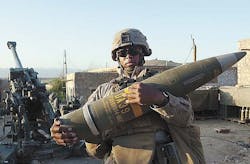Army looks to five companies to develop munitions technology for next-generation armament
PICATINNY ARSENAL, N.J., 30 June 2015. U.S. Army munitions technology experts are choosing five companies to help design and build new technologies for next-generation Army armaments and munitions, ranging from precision-guided munitions, warheads, fuzes, mortars, and different kinds of conventional ammunition.
Officials of the Army Contracting Command at Picatinny Arsenal, N.J., have selected the five companies to compete over the next five years for munitions technology projects involved in the Rapid Prototyping & Technology Initiative-Generation 2 (RPTI-GEN2).
The five contractors will help the Army Armament, Research, Development, and Engineering Center (ARDEC) design, build, and test new munitions technologies for new and emerging Army requirements.
The companies are:
-- Universal Technical Resource Services Inc. in Cherry Hill, N.J;
-- TRC Defense Systems LLC in Madison, Ala.;
-- Savit Corp. in Rockaway, N.J.;
-- Middle Bay Solutions LLC in Huntsville, Ala.; and
-- Subsystem Technologies Inc. in Arlington, Va.
Related: Should some smart munitions be classified as unmanned aerial vehicles (UAVs)?
These companies will compete for different jobs over the next five years worth as much as a collective $200 million. Funding and work location will be determined with each order.
ARDEC is the Army's principal researcher, developer, and sustainer of current and future armament and munitions systems, and is involved in the Soldier and Future Combat Systems and in advanced weapons that use technologies like high-power microwaves, high-energy lasers, and nano-technology.
Picatinny Arsenal is the joint center of excellence for armaments and munitions, and helps all branches of the U.S. military. The organization develops and buys advanced conventional weapons advanced ammunition, including IED defeat technologies; small, medium and large caliber conventional ammunition; precision-guided munitions; mortars; fire-control systems; small-arms weapon systems; howitzers; gunner protection armor; warheads; fuzes; and insensitive munitions.
The RPTI-GEN2 is an initiative of the Joint Munitions & Lethality (JM&L) Life Cycle Management Command (LCMC) Strategic Sourcing Initiative to increase ARDEC's ability to provide reliable, responsive, and cost effective munitions technologies.
ARDEC also is responsible for developing quick-reaction munitions technologies for rapidly changing battlefield conditions in the global war on terror.
Related: Army taps Raytheon to build another 209 Excalibur heavy artillery smart munitions
The five RPTI-GEN2 contractors will develop enabling technologies and prototypes in sis separate areas: materials and processes, component fabrication and equipment; product assembly; testing support; and engineering services.
Materials and processes involves electronics, optics,, lasers, new materials, composites, coatings, adhesives, metals and alloys, and other processes.
Component fabrication and equipment involves armaments; non-energetics; energetics; munitions; electronics; metallic components; and non-metallic components. Product assembly involves combining armaments, non-energetics, energetics, optics, lasers, and electronics into a final lethal, scalable, or counter-lethality platform, armament, or product.
Systems engineering and integration involves systems engineering, system of systems capability, integration, and product fielding. Testing support and capabilities involves energetic and non-energetic materials. Engineering services involves supporting the life cycle engineering needs from cradle to grave.
This contract runs through June 2020. For more information contact Picatinny Arsenal online at www.pica.army.mil, or ARDEC at www.ardec.army.mil.

